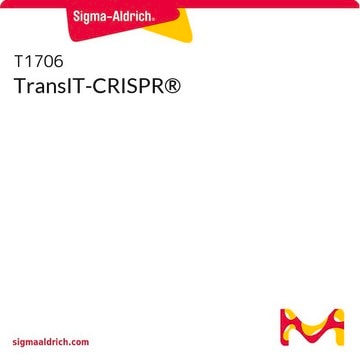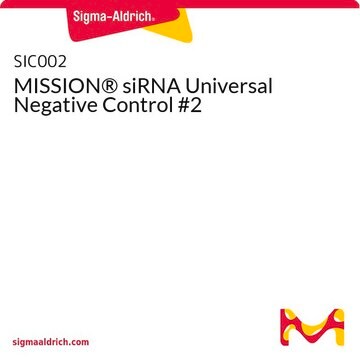SITRAN-RO
Roche
X-tremeGENE™ siRNA Transfection Reagent
Polymer reagent for delivering siRNA to common cell lines
About This Item
Produtos recomendados
grau
for molecular biology
Nível de qualidade
uso
sufficient for 2,000 transfections (04476115001)
sufficient for 400 transfections (04476093001)
embalagem
pkg of 1 mL (04476093001 [1 mg/ml])
pkg of 5 × 1 mL (04476115001 [5 x 1 mg/ml])
fabricante/nome comercial
Roche
concentração
1 mg/mL
técnica(s)
transfection: suitable
Condições de expedição
wet ice
temperatura de armazenamento
2-8°C
Categorias relacionadas
Descrição geral
This innovative reagent forms a complex with siRNA, as well as with mixtures of siRNA and plasmid DNA (cotransfection), and efficiently delivers the nucleic acids into animal cells to induce gene silencing. Transfection is achieved in just a few steps: mix and incubate diluted transfection reagent with diluted siRNA, then add this complex to cells. Because X-tremeGENE siRNA Transfection Reagent functions exceptionally well in the presence or absence of serum and demonstrates low cytotoxicity, it can be used without media changes. The product is animal-component free.
Contents
Solution filtered through 0.2 μm pore size membrane, supplied in polypropylene tubes.
Aplicação
Características e benefícios
- Knock down gene expression over 90% in many different cell types.
- Maximize experimental flexibility with a single reagent for siRNA- and cotransfection-based gene-knockdown experiments.
- Produce meaningful results using a reagent that exhibits low cytotoxicity, ensuring that the cellular effects you observe are due to the transfected siRNA rather than the transfection procedure.
- Work with or without serum, avoiding medium changes (e.g., to serum-free medium) before or after transfection.;
X-tremeGENE siRNA Transfection Reagent is a proprietary blend of lipids and other components, free of animal products.
Qualidade
Cytotoxicity analysis: HEK-293 cells are exposed to siRNA/X-tremeGENE siRNA Reagent complexes for 72 hours in the presence of serum, without a media change. Cytotoxicity is then tested by analyzing the cells with the WST-1 Cell Proliferation Reagent (Roche).
Outras notas
Informações legais
produto relacionado
Código de classe de armazenamento
12 - Non Combustible Liquids
Classe de risco de água (WGK)
nwg
Ponto de fulgor (°F)
does not flash
Ponto de fulgor (°C)
does not flash
Certificados de análise (COA)
Busque Certificados de análise (COA) digitando o Número do Lote do produto. Os números de lote e remessa podem ser encontrados no rótulo de um produto após a palavra “Lot” ou “Batch”.
Já possui este produto?
Encontre a documentação dos produtos que você adquiriu recentemente na biblioteca de documentos.
Os clientes também visualizaram
Artigos
Small inhibitory RNAs offer easy gene expression knockdown in mammalian cells, revolutionizing gene research.
Transfection introduces genetic material into cells, aiding research in gene expression and cell biology.
This brief webinar provides an overview of what transfection is and the methods that are used to introduce DNA or RNA into eukaryotic cells.
Genetic engineering enables large-scale expression and isolation of recombinant proteins for research purposes.
Protocolos
X-tremeGENE™ siRNA Transfection Reagent Protocol & Troubleshooting
Protocols for Transfecting Common Cell Lines with X-tremeGENE™ Transfection Reagents
Conteúdo relacionado
Browse our convenient transfection reagent selection guide to match the best reagent for your specific cell line and application needs.
Nossa equipe de cientistas tem experiência em todas as áreas de pesquisa, incluindo Life Sciences, ciência de materiais, síntese química, cromatografia, química analítica e muitas outras.
Entre em contato com a assistência técnica















